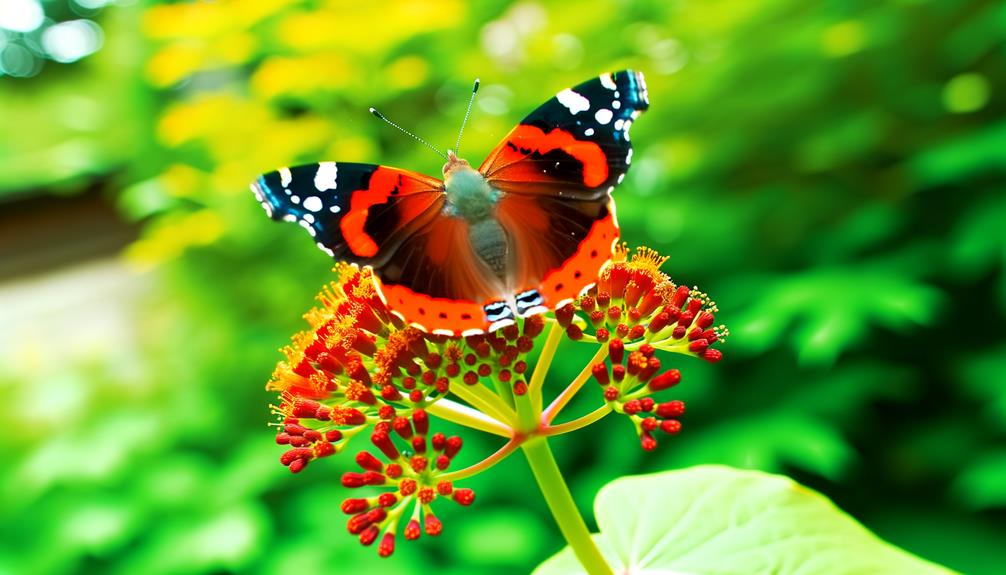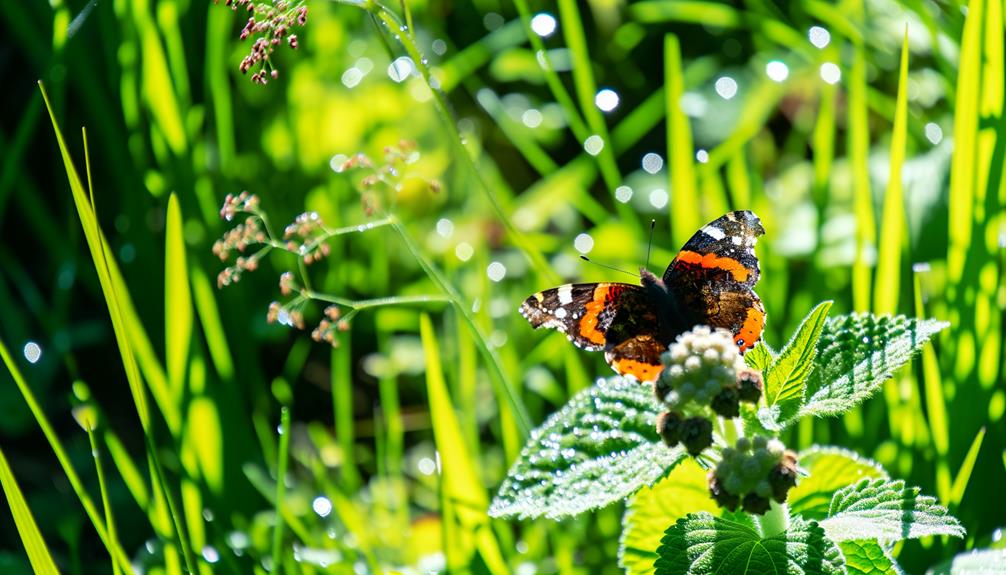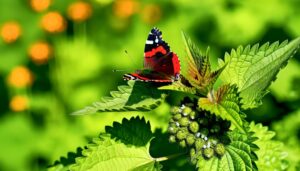What Makes the Red Admiral Butterfly’s Orange Spots Unique?
The Red Admiral butterfly, Vanessa atalanta, is distinguished by its velvety black wings featuring vivid orange-red bands and conspicuous white spots. Forewings exhibit a prominent red diagonal stripe and apical white spots, while the hindwings flaunt a red marginal band with minor blue spots.
A wingspan of 45 to 50 millimeters highlights its medium size. This species is widely distributed across North America, Europe, Asia, and North Africa, thriving in temperate climates.
Its visual allure is matched by ecological versatility, from urban gardens to woodlands. Discover the fascinating behavioral traits and conservation efforts surrounding this butterfly.

Key Takeaways
- The Red Admiral butterfly features velvety black wings with striking orange-red bands and white spots.
- Forewings display a prominent red diagonal stripe and distinctive white spots near the apex.
- The butterfly's wingspan ranges from 45 to 50 millimeters (approximately 2 to 3 inches).
- Hindwings have a red marginal band with small blue spots.
Physical Appearance

The Red Admiral Butterfly (Vanessa atalanta) exhibits a striking appearance characterized by its velvety black wings adorned with vivid red bands and white spots. Belonging to the family Nymphalidae, this lepidopteran showcases a wingspan ranging from 45 to 50 millimeters.
The forewings feature a prominent red stripe traversing diagonally, complemented by a series of white spots near the apex. The hindwings, mainly black, are edged with a red marginal band, which houses a sequence of small blue spots.
The underside is a more cryptic brown with mottled patterns, providing effective camouflage against predators. The Red Admiral's distinct coloration not only serves as a visual deterrent but also plays a role in thermoregulation and mate attraction.
Habitat and Range
The Red Admiral butterfly (Vanessa atalanta) exhibits a broad geographic distribution, inhabiting temperate regions across North America, Europe, and Asia.
Favoring mild climates, this species thrives in diverse environments, ranging from woodlands and gardens to coastal areas.
Its adaptability to various habitats underscores its resilience and widespread presence across multiple continents.
Preferred Climate Conditions
Adapted to a wide range of environments, the Red Admiral butterfly (Vanessa atalanta) thrives in temperate regions across North America, Europe, Asia, and North Africa. This species exhibits a marked preference for mild climates, typically found in regions with moderate temperatures and sufficient humidity.
Vanessa atalanta is highly adaptable, frequenting both urban and rural landscapes, including woodlands, gardens, and meadows. The butterfly's larval host plants, primarily nettles (Urtica spp.), are abundant in these climates, providing essential resources for development.
Seasonal fluctuations, such as warm summers and mild winters, facilitate their migratory behavior, ensuring survival and reproduction. The Red Admiral's resilience in varied climatic conditions underscores its ecological versatility and widespread distribution.
Geographic Distribution Areas
Extending across continents, Vanessa atalanta inhabits diverse ecological zones, from temperate woodlands to urban gardens, spanning North America, Europe, Asia, and North Africa.
This ubiquitous species exhibits remarkable adaptability to various habitats, thriving in environments ranging from forests to coastal regions. Observations indicate that their migration patterns are significantly influenced by climate and seasonal changes, enhancing their distribution versatility.
Key regions for Vanessa atalanta include:
- North America: Mainly found in the United States and southern Canada, favoring deciduous forests and riparian zones.
- Europe: Widely distributed from the Mediterranean to Scandinavia, indicating a broad ecological amplitude.
- Asia: Inhabits temperate and subtropical zones, frequently observed in both rural and urban landscapes.
Understanding these distribution patterns is essential for conservation efforts.
Lifecycle Stages

Understanding the lifecycle stages of the Red Admiral butterfly (Vanessa atalanta) involves examining its developmental phases from egg to adult, each marked by distinct physiological and behavioral changes.
The lifecycle begins with oviposition, where females deposit eggs singly on host plants, primarily from the Urticaceae family.
The larval stage follows, characterized by black caterpillars with white spots and spines. These larvae undergo five instars, each progressively larger.
After the final molt, the larva forms a chrysalis, entering the pupal stage. The pupal stage is marked by metamorphosis, culminating in the emergence of the adult butterfly.
The adult stage features a distinctive orange and black wing pattern, vital for mating and territorial behaviors.
This complex lifecycle guarantees species survival and adaptability.
Feeding Habits
The feeding habits of the Red Admiral butterfly (Vanessa atalanta) encompass a diverse range of dietary preferences, primarily involving nectar from various flowering plants and supplementary sources like tree sap and overripe fruit.
Observations indicate that this species frequently visits:
- Buddleia davidii (Butterfly Bush)
- Echinacea purpurea (Purple Coneflower)
- Prunus avium (Wild Cherry)
These choices suggest a preference for high-energy resources, essential for sustaining their migratory behavior and reproductive activities.
The proboscis, an elongated feeding apparatus, is adapted for accessing deep floral nectaries.
Additionally, Vanessa atalanta exhibits saprophagous tendencies, consuming decaying organic matter, which is particularly prevalent in fall when nectar sources diminish.
This trophic flexibility underscores their ecological resilience and adaptability in varied habitats.
Role in Pollination

Vanessa atalanta, commonly known as the Red Admiral butterfly, plays a pivotal role in pollination by facilitating the transfer of pollen across various angiosperms through its frequent foraging activities.
Classified under the family Nymphalidae, this lepidopteran visits a diverse array of flowers, including species such as Buddleja davidii and Asteraceae. Its proboscis is adapted for nectar extraction, inadvertently collecting and transferring pollen between floral structures.
This mutualistic interaction promotes genetic diversity and reproductive success among flowering plants. The Red Admiral's wide geographic range and migratory behavior further enhance its pollination efficacy, making it an essential component in both temperate and subtropical ecosystems.
Consequently, Vanessa atalanta considerably contributes to the sustainability of plant populations and overall biodiversity.
Behavior Patterns
In addition to their significant role in pollination, Red Admiral butterflies exhibit distinct behavior patterns that are essential to their survival and ecological interactions. Scientifically known as *Vanessa atalanta*, these butterflies demonstrate territoriality and migratory behaviors crucial for their lifecycle.
Detailed observations have highlighted three notable behaviors:
- Territorial Defense: Males establish and aggressively defend territories to attract females, ensuring reproductive success.
- Nectar Feeding: Red Admirals frequently visit flowering plants, exhibiting a preference for nectar sources like buddleia and ivy, which are fundamental for their energy requirements.
- Seasonal Migration: These butterflies undertake long-distance migrations between temperate and subtropical regions, a survival strategy to evade harsh climates.
These behaviors underscore their adaptability and ecological significance within their habitats.
Conservation Status

Given their ecological significance and the threats they face, understanding the conservation status of *Vanessa atalanta* is essential for developing effective preservation strategies. The Red Admiral butterfly, known for its distinctive orange and black wing patterns, plays a vital role in pollination and serves as an indicator species for environmental health. Although currently classified as 'Least Concern' by the IUCN, factors such as habitat loss, climate change, and pesticide use pose significant risks. Conservation efforts must focus on habitat restoration and pollution reduction to guarantee their survival.
| Criteria | Status | Threats |
|---|---|---|
| IUCN Classification | Least Concern | Habitat loss, climate change |
| Population Trends | Declining | Pesticide use |
| Key Habitats | Meadows, woodlands | Urbanization |
| Conservation Actions | Habitat restoration | Pollution reduction |
Conclusion
The red admiral butterfly, with its striking orange wings adorned with spots, symbolizes a vibrant jewel of the Lepidoptera order. A frequent visitor to gardens and meadows, this butterfly is known for its graceful flight and adaptability to various climates. Enthusiasts seeking red spotted admiral facts will find that this species thrives on nectar from flowers like milkweed and asters. Its caterpillars often feed on nettles, playing a crucial role in the ecological balance of their habitats.
Its presence in diverse habitats, complex lifecycle, and essential role in pollination underscore its ecological importance.
Behavioral patterns and feeding habits reflect intricate adaptations, while its conservation status serves as a sentinel for environmental health.
Therefore, the red admiral stands as both a scientific marvel and a significant thread in the ecological tapestry.






